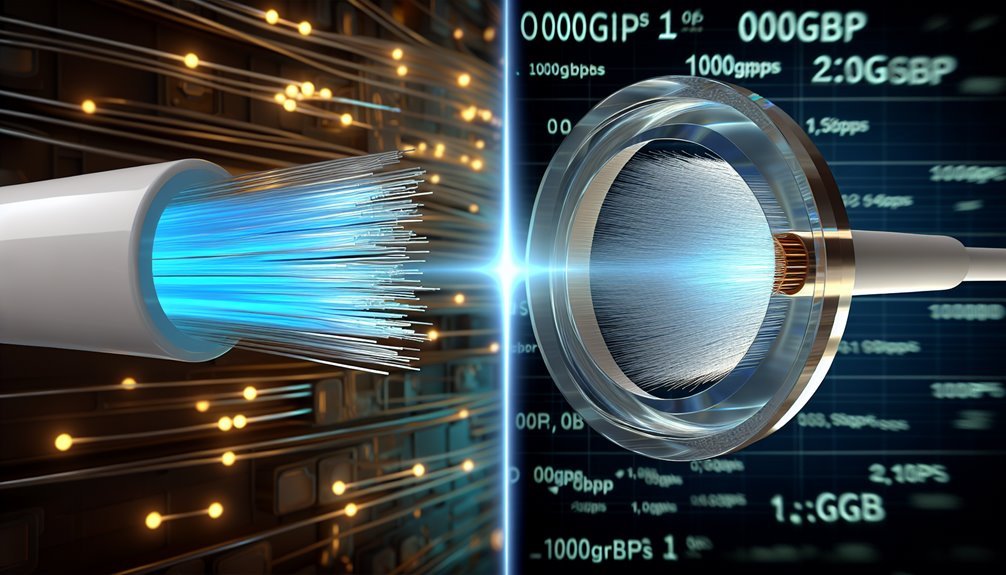
Just as you’re finalizing your network infrastructure upgrade plans, fiber optic cable technology has reached its undeniable superiority over copper in 2025. You’ll find that modern fiber solutions now deliver multi-terabit throughput while copper remains constrained by its inherent physical limitations. This bandwidth revolution isn’t merely incremental—it’s transformative. The gap between these technologies continues to widen across critical performance metrics including interference immunity, transmission distance, energy efficiency, and security. What does this mean for your five-year infrastructure strategy?
The Bandwidth Revolution: How Fiber Transformed Data Capacity
Bandwidth constraints, once the bottleneck of global telecommunications, underwent a paradigm shift with the widespread adoption of fiber optic technology. You’ll find that modern fiber installations routinely deliver multi-terabit data throughput capabilities—exponentially surpassing copper’s fundamental physical limitations.
Fiber optic deployment continues accelerating across enterprise and residential sectors, enabling applications previously unimaginable with traditional metallic conductors. The transmission medium’s inherent characteristics allow for near-lossless signal propagation across substantial distances, eliminating the impedance and electromagnetic interference issues that plague copper implementations.
This revolution fundamentally altered network architecture paradigms, as you now leverage photonic transmission rather than electron movement for mission-critical data transfer.
Electromagnetic Interference: Fiber’s Immunity Edge
While copper-based transmission systems remain susceptible to electromagnetic disturbances, fiber optic cable operate with near-complete immunity to electromagnetic interference (EMI). You’ll notice this immunity directly translates to superior data transmission quality in environments where electrical equipment, power lines, or motors generate disruptive electromagnetic fields.
This EMI resistance provides substantial installation flexibility across challenging deployments. You can route fiber through industrial facilities, alongside power infrastructure, or within data centers without implementing costly shielding solutions required for copper alternatives. The glass or plastic core’s light-based transmission method effectively eliminates crosstalk and signal degradation issues that plague metallic conductors in EMI-rich environments.
Distance & Signal Integrity: The Long-Range Advantage
Beyond EMI considerations, fiber optic technology demonstrates its most compelling advantage in long-distance transmission capabilities. You’ll achieve reliable data transfer over distances exceeding 40 kilometers without signal regeneration, while copper maxes out at approximately 100 meters before significant signal loss occurs.
Fiber’s superior signal strength retention stems from its photonic transmission method—light pulses experience minimal attenuation compared to copper’s electrical signals. This translates directly to your network’s performance metrics: lower bit error rates, higher throughput, and consistent latency even at extreme distances.
For 2025’s bandwidth-intensive applications, this distance-to-signal-integrity ratio represents a critical infrastructure differentiator that copper simply can’t match.
Energy Efficiency & Sustainability in Modern Networks
As data centers increasingly prioritize environmental responsibility, fiber optic infrastructure delivers measurable sustainability advantages with up to 85% less energy consumption compared to equivalent copper installations. You’ll find these energy savings translate directly to reduced operational costs and smaller carbon footprints throughout your deployment lifecycle.
Fiber’s minimal power requirements enable more efficient network lifecycle management, allowing you to allocate resources strategically. Your fiber networks don’t require the cooling infrastructure copper demands, further reducing facility energy needs. This creates cascading benefits for energy grid optimization, as each watt saved at the cable level compounds across your entire network architecture.
Security Advantages of Light-Based Transmission
The inherent properties of photonic transmission provide fiber optic networks with significant security advantages compared to traditional copper infrastructure. When you implement fiber, you’ll experience near-immunity to electromagnetic interference and eavesdropping attempts. Unlike copper cables that emit detectable electromagnetic signals, fiber’s light-based transmission remains contained within the glass core.
Your data encryption protocols operate more effectively over fiber, supporting higher-level cryptographic standards without performance degradation. Physical security is enhanced as fiber cable tampering attempts typically cause complete signal loss, triggering immediate alerts.
Fiber’s immunity to remote monitoring techniques that work against copper makes it the superior choice for security-conscious network deployments in 2025.
Economic Analysis: Total Cost of Ownership Comparison
Five critical factors determine fiber optic’s superior total cost of ownership compared to copper infrastructure in 2025. Initial capital expenditure is higher, but you’ll see ROI within 36 months due to fiber’s 20+ year lifecycle versus copper’s 5-7 years.
Operating costs decrease by 73% annually with fiber’s minimal power consumption. Maintenance requirements drop significantly with immunity to electromagnetic interference and corrosion resistance.
Bandwidth scalability eliminates future replacement costs—your initial fiber installation supports 400Gbps+ without hardware overhauls. Finally, fiber’s 60% smaller physical footprint reduces real estate costs in data centers.
When calculating TCO, fiber’s long-term economics clearly outperform copper in every metric.
